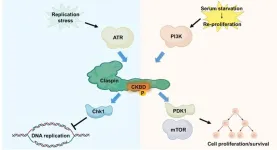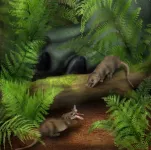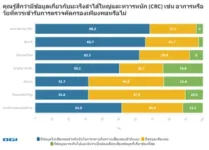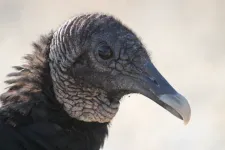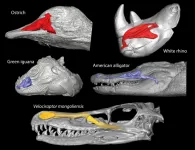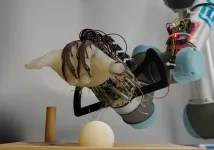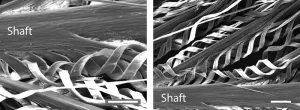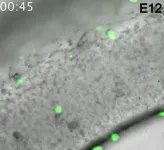When cells sense the cue for growth
2023-04-12
(Press-News.org)
Researchers of the Genome Dynamics Project team at Tokyo Metropolitan Institute of Medical Science ·revealed new mechanism controlling cellular proliferation in response to serum, which triggers growth of resting cells.
One of the key pathways for cellular growth is the phosphoinositide 3-kinase (PI3K) –mTOR (mechanistic/mammalian target of rapamycin) pathway. mTOR regulates the cellular response to nutrient availability. Dysregulation of the mTOR signaling pathway is intimately involved in many human diseases, especially the multitude of different human cancers. This pathway mainly plays major roles during G1/G0, preparative stages for proliferation. Another key pathway during proliferation cycle, especially during S phase, is the replication stress checkpoint pathway. This pathway protects the genome from potential damages that may occur during the process of DNA replication. Both pathway needs to be precisely regulated in order to prevent genome instability that would lead to uncontrolled growth of cancer cells.
Claspin is a key factor that mediates the replication stress checkpoint signaling. It receives a signal from the upstream lipid kinase, ATR, and transmits it to a downstream kinase, Chk1. Chk1 prevents the genome-threatening cell cycle progression in the face of stalled replication forks. These nuclear events have not been linked to PI3K-mTOR pathway that has been assumed to mainly occur in cytoplasm, although the presence of the latter factors in nuclei has been reported.
Living organisms are exposed to various types of stress, and they have developed stress response systems to deal with these situations. In the cellular response pathway to replication stress, a signal is transmitted from sensor kinase (ATR) to effector kinase (Chk1) to temporarily stop the progression of replication and cell division. Claspin is a mediator of this signal, which is essential for the checkpoint signal transduction.
Chi-Chun Yang, Ph.D, and Hisao Masai, Ph.D, at the Tokyo Metropolitan Institute of Medical Science discovered a novel function of Claspin in the nutrition-induced signaling pathway. The researchers found that Claspin is essential for activation of PI3K-PDK1-mTOR pathway and that of downstream factors as well as for cell survival during the serum induced growth restart.
Masai said, “This was completely unexpected. The PI3K-mTOR pathway, the major nutrient-induced pathway, has been studied intensively, but no functional links to the nuclear events/factor have been known. We are excited to know that Claspin plays unexpected and essential roles in the mTOR pathway. Our studies also suggest striking similarity of Claspin-mediated activation of replication checkpoint and potential mode of its action in the nutrition-induced signal transduction from the upstream lipid kinase (PI3K) to the downstream kinases (PDK1 and mTOR).”
The study would provide new targets for therapeutic interventions of metabolic disorders such as obesity, diabetes, and cancers resulting from the dysregulation of the mTOR pathway.
END
ELSE PRESS RELEASES FROM THIS DATE:
2023-04-12
Since the 1950s, humanity has produced an estimated 8.3bn tons of plastic, adding a further 380m tons to this amount each year. Only 9% of this gets recycled. The inevitable result is that plastic is everywhere, from the depths of the oceans to the summit of Everest – and notoriously, inside the tissues of humans and other organisms.
The long-term effects of ingested plastic on people aren’t yet known. But in rodents, ingested microplastics can impair the function of the liver, intestines, and exocrine and reproductive organs.
Especially ...
2023-04-12
Reducing global greenhouse gas emissions is critical to avoiding a climate disaster, but current carbon removal methods are proving to be inadequate and costly. Now researchers from the University of California, Berkeley, have proposed a scalable solution that uses simple, inexpensive technologies to remove carbon from our atmosphere and safely store it for thousands of years.
As reported today in the journal Proceedings of the National Academy of Sciences, researchers propose growing biomass crops to capture carbon from the air, then burying the harvested vegetation in engineered dry biolandfills. This ...
2023-04-12
A research team led by Seishiro Tada and Takanobu Tsuihiji of the University of Tokyo shows that the living warm-blooded descendants of theropod dinosaurs evolved a better nasal cooling system aided by larger nasal cavities than cold-blooded animals. The study provides clues to the evolution of nasal cooling in warm-blooded animals from their theropod dinosaur ancestors.
Endotherms, or warm-blooded animals, maintain their high body temperature through internal heat sources. Birds, humans, and other mammals are endotherms. But ectotherms, or cold-blooded animals such as reptiles, use external heat sources to keep ...
2023-04-12
Researchers have designed a low-cost, energy-efficient robotic hand that can grasp a range of objects – and not drop them – using just the movement of its wrist and the feeling in its ‘skin’.
Grasping objects of different sizes, shapes and textures is a problem that is easy for a human, but challenging for a robot. Researchers from the University of Cambridge designed a soft, 3D printed robotic hand that cannot independently move its fingers but can still carry out a range of complex movements.
The robot hand was trained to ...
2023-04-12
An extreme closeup of feathers from a bird with an uncanny ability to hold water while it flies could inspire the next generation of absorbent materials.
With high resolution microscopes and 3D technology, researchers at Johns Hopkins University and Massachusetts Institute of Technology captured an unprecedented view of feathers from the desert-dwelling sandgrouse, showcasing the singular architecture of their feathers and revealing for the first time how they can hold so much water.
“It’s super fascinating to see how nature managed to create structures so perfectly efficient to take ...
2023-04-12
Time-restricted fasting diets could cause fertility problems according to new research from the University of East Anglia.
A new study published today shows that time-restricted fasting affects reproduction differently in male and female zebrafish.
Importantly, some of the negative effects on eggs and sperm quality can be seen after the fish returned to their normal levels of food consumption.
The research team say that while the study was conducted in fish, their findings highlight the importance of considering not just the effect of fasting on weight and health, but also on fertility.
Prof Alexei Maklakov, from UEA’s School of Biological Sciences, said: “Time-restricted ...
2023-04-12
Many birds’ feathers are remarkably efficient at shedding water — so much so that “like water off a duck’s back” is a common expression. Much more unusual are the belly feathers of the sandgrouse, especially Namaqua sandgrouse, which absorb and retain water so efficiently the male birds can fly more than 20 kilometers from a distant watering hole back to the nest and still retain enough water in their feathers for the chicks to drink and sustain themselves in the searing deserts ...
2023-04-12
A team from the Nagoya University Graduate School of Medicine in Japan has uncovered new information about how microglia, the resident immune cells in the brain, colonize the brain during the embryonic stage of development. Although erythromyeloid progenitors (EMPs) were previously thought to divide into either microglia or macrophages, the group found that macrophages that enter the brain primordium —the brain in its earliest recognizable stage of development— can become microglia at later stages of development. These findings demonstrate the plasticity of these ...
2023-04-12
High levels of the body’s own cannabinoid substances protect against developing addiction in individuals previously exposed to childhood maltreatment, according to a new study from Linköping University in Sweden. The brains of those who had not developed an addiction following childhood maltreatment seem to process emotion-related social signals better.
Childhood maltreatment has long been suspected to increase the risk of developing a drug or alcohol addiction later in life. Researchers at Linköping University have previously shown that this risk is three times higher if you have been exposed to childhood maltreatment ...
2023-04-12
New research from the Peter Doherty Institute for Infection and Immunity (Doherty Institute) has found that pregnant women display a strong immune response to SARS-CoV-2 infection, comparable to that of non-pregnant women.
Published in JCI Insight, the study looked at the immune responses to SARS-CoV-2 in unvaccinated pregnant and non-pregnant women and found similar levels of antibodies and T and B cell responses, responsible for long-term protection.
Lead author of the paper, University of ...
LAST 30 PRESS RELEASES:
[Press-News.org] When cells sense the cue for growth
